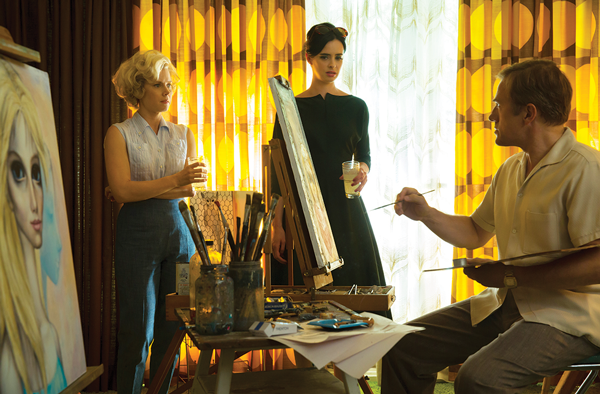
BY SEAN EGAN | This biopic has the strange distinction of being both one of the most and least Tim Burton-y movies Tim Burton has ever made. Signs of the goth-king auteur’s favorite themes and visual motifs abound from the opening sequence, depicting thousands of art posters being printed — a sight immediately reminiscent of the Rube Goldberg wonders of “Pee-Wee’s Big Adventure” and the turning gears of mass production central to his adaptations of “Charlie and the Chocolate Factory” and “Sweeney Todd.” The kitschy, 1950s aesthetic found in movies like “Edward Scissorhands” and “Mars Attacks” are evoked heavily here through the set design and costuming. And, most important of all, the film focuses on a misunderstood, alienated outsider artist — a staple of essentially every Burton film ever.
But “Big Eyes” also represents a very distinct departure for the director. Known primarily for his big-budget spectacles, this is a far more restrained affair, finding the director working with the lowest budget of his career and focusing on more grounded human drama. Collaborating with screenwriters Scott Alexander and Larry Karaszewski (the scribes responsible for Burton’s masterful “Ed Wood”), “Big Eyes” dramatizes the lives of Walter and Margaret Keane, the married couple responsible for unleashing the genuinely strange, maudlin paintings of large eyed-children referenced in the title.
FILM | BIG EYES
Written by Scott Alexander & Larry Karaszewski
Directed by Tim Burton
Runtime: 106 minutes
Opening Wide on Dec. 25
Visit bigeyesfilm.com
The stranger-than-fiction true story follows the personal journey of introverted Margaret (Amy Adams), the artist behind the pictures, as her charismatic, wheeler-dealer husband Walter (Christoph Waltz) takes credit for her work, building an unlikely art empire in the process. As Walter’s ego balloons, Margaret begins to regret her decisions, and learns to assert herself — culminating in an outrageous courtroom paint-off between the two.
Though the story is more realistic and the tone lighter than his usual fare, “Big Eyes” is unmistakably a Burton picture. The whole thing seems to be the director’s skewed take on Sirkian melodrama (complete with rich, Technicolor-esque cinematography from Bruno Delbonnel) — which is a weird, but not unwelcome change of pace for the director. It’s incredibly satisfying to see his gothic, German-expressionistic tendencies clash up against the candy colored world of the movie — such as when a guilt-ridden Margaret begins to hallucinate her signature, saucer-sized eyes on supermarket patrons. It’s a genuinely exciting and disturbing sequence, and one of the director’s most visually and emotionally striking scenes in recent years.
Burton’s oddball vision is supported by talented collaborators. Alexander and Karaszewki’s script moves along at a good pace, deftly shifting between (and mixing) quirky comedy and domestic drama. Waltz puts his grinning, wolf-in-sheep’s-clothing persona to good use, turning in perhaps his most over-the-top comedic performance to date, while still being able to transform into a hulking Noseferatu-like figure of domestic abuse. Best of all is Adams, who gives Margaret a quiet dignity, revealing her slowly building regret, anger and fear primarily through her expressive face and, yes, eyes.
“Big Eyes” comes close enough to being something great that it’s frustrating that it doesn’t capitalize on its incredible potential. At some points it seems as if Burton and his collaborators didn’t have enough faith in the source material or their audience. Intrusive voice-over narration articulates plot points and, worse, describes characters’ feelings rather than allowing the performances to speak for themselves. Danny Elfman’s score similarly does a little too much hand holding, aggressively telling the audience what to feel and precisely when to feel it. And a Lana Del Rey song employed during the middle of the film is comically out of place, dabbling in the kind of plot synopsis lyricism more fitting for a sitcom theme song.
Most disappointing is the movie’s refusal to explore its characters and the complicated social issues it touches upon more fully. While Waltz and Adams turn in excellent performances, the screenplay only hints at their deeper motivations, and lacks a nuance on par with the acting. Though the film gets credit for raising interesting questions about the nature of art and its relationship to commerce, as well as the struggles of women in society and the art world, it deals with these ideas in a surface level way.
Still, “Big Eyes” is not a bad movie by any stretch of the imagination — in fact it’s really quite good — light, stylish and fun. It’s certainly Burton’s best, most fully realized project in years, and strikes of an old pro trying something new and challenging himself. While “Big Eyes” might not be a late career masterpiece, it’s an enjoyable crowd pleaser, and a quiet return to form from one of cinema’s most distinctive directors.

















